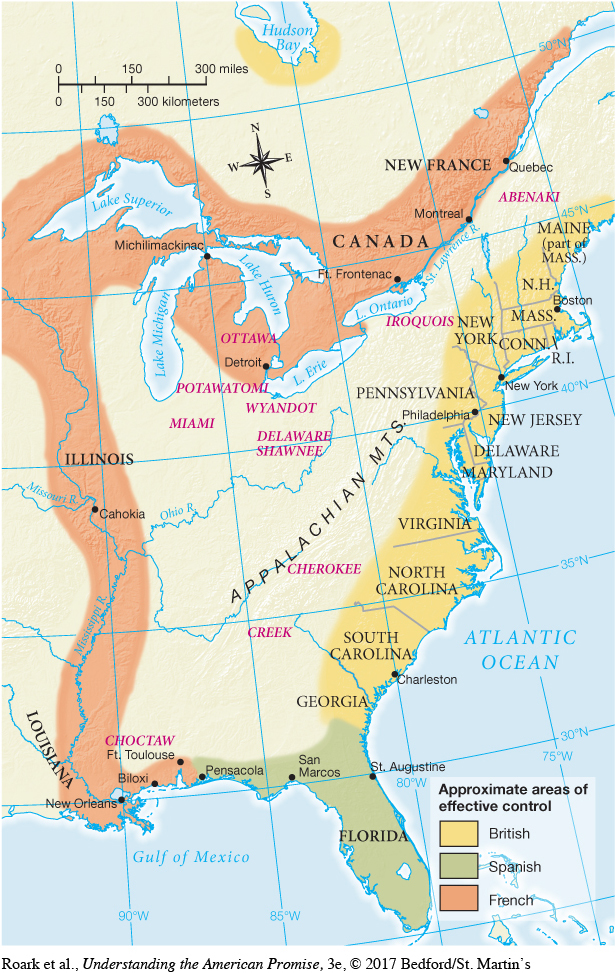Trade and Conflict in the North American Borderlands
British power defended the diverse inhabitants of its colonies from Indian, French, and Spanish enemies on their borders—as well as from foreign powers abroad. Royal officials warily eyed the small North American settlements of New France and New Spain for signs of threats to the colonies.
Alone, neither New France nor New Spain jeopardized British North America, but with Indian allies they could become a potent force that kept colonists on their guard (Map 5.4). Native Americans’ impulse to defend their territory from colonial incursions competed with their desire for trade, which tugged them toward the settlers. As a colonial official observed in 1761, “A modern Indian cannot subsist without Europeans. . . . [The European goods that were] only conveniency at first [have] now become necessity.” To obtain such necessities as guns, ammunition, clothing, and sewing utensils manufactured largely by the British, Indians trapped beavers, deer, and other furbearing animals. [[LP Map: M05.04 Zones of Empire in Eastern North America /

British, French, Spanish, and Dutch officials competed for the fur trade. Indians took advantage of this competition to improve their own prospects, playing one trader and empire off another. Indian tribes and confederacies also competed among themselves for favored trading rights with one colony or another, a competition colonists encouraged.
The shifting alliances and complex dynamics of the fur trade struck a fragile balance along the frontier. The threat of violence from all sides was ever present, and the threat became reality often enough for all parties to be prepared for the worst. In the Yamasee War of 1715, for example, the Yamasee and Creek Indians—with French encouragement—mounted a coordinated attack against colonial settlements in South Carolina. The Cherokee Indians, traditional enemies of the Creeks, refused to join the attack. Instead, they protected their access to British trade goods by allying with the colonists and turning the tide of battle, triggering a murderous rampage of revenge by the colonists against the Creeks and Yamasee.
Relations between Indians and colonists differed from colony to colony and from year to year. But the British colonists’ nagging perceptions of menace on the frontier kept them continually hoping for help from the British to keep the Indians at bay and to maintain the essential flow of trade. In 1754, the British colonists’ endemic competition with the French flared into the Seven Years’ War (also known as the French and Indian War), which would inflame the frontier for years (see “French-British Rivalry in the Ohio Country” in chapter 6). Colonists agreed that Indians made deadly enemies, profitable trading partners, and powerful allies.

The Spanish kept an eye on the Pacific coast, where Russian hunters in search of seals and sea otters threatened to become a permanent presence on New Spain’s northern frontier. To block Russian access to present-day California, officials in New Spain mounted a campaign to build forts (called presidios) and missions there. In 1769, an expedition headed by a military man, Gaspar de Portolá, and a Catholic priest, Junípero Serra, traveled north from Mexico to present-day San Diego, where they founded the first California mission, San Diego de Alcalá. They soon journeyed all the way to Monterey, which became the capital of Spanish California. There Portolá established a presidio in 1770 “to defend us from attacks by the Russians,” he wrote. The same year, Serra founded Mission San Carlos Borroméo de Carmelo in Monterey to convert the Indians and recruit them to work to support the soldiers and other Spaniards in the presidio. By 1772, Serra had founded other missions along the path from San Diego to Monterey. [[LP Spot Map: SM05.02 Spanish Missions in California/
One Spanish soldier praised the work of the missionaries, writing that “with flattery and presents [the missionaries] attract the savage Indians and persuade them to adhere to life in society and to receive instruction for a knowledge of the Catholic faith, the cultivation of the land, and the arts necessary for making the instruments most needed for farming.” Yet for the Indians, the Spaniards’ California missions had horrendous consequences, as they had elsewhere in the Spanish borderlands. European diseases decimated Indian populations, Spanish soldiers raped Indian women, and missionaries beat Indians and subjected them to near slavery. Indian uprisings against the Spaniards occurred repeatedly, but the presidios and missions endured as feeble projections of the Spanish empire along the Pacific coast. (See “Analyzing Historical Evidence: Spanish Priests Report on California Missions.”)
Understanding the American Promise 3ePrinted Page 126
Section Chronology